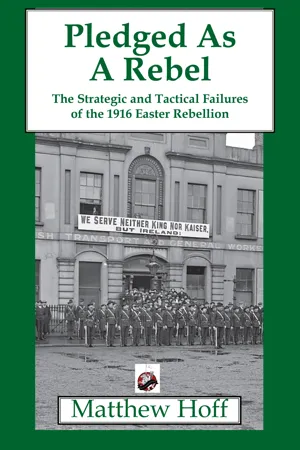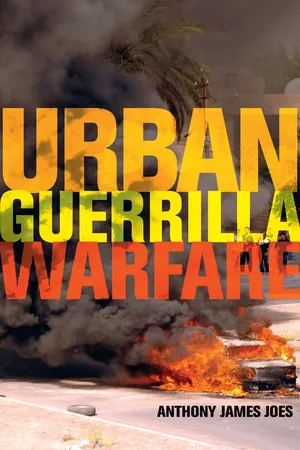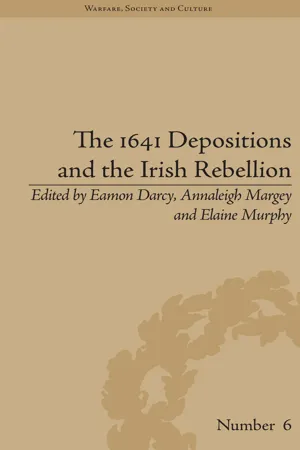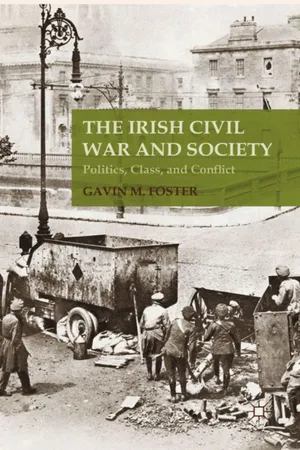History
Irish Rebellion
The Irish Rebellion refers to a series of uprisings and conflicts in Ireland, particularly the 1641 rebellion and the Easter Rising of 1916. These events were driven by a desire for independence from British rule and resulted in significant political and social consequences for Ireland. The rebellions played a crucial role in shaping Irish history and the ongoing struggle for self-determination.
Written by Perlego with AI-assistance
Related key terms
5 Key excerpts on "Irish Rebellion"
- eBook - ePub
Ireland's 1916 Rising
Explorations of History-Making, Commemoration & Heritage in Modern Times
- Mark McCarthy(Author)
- 2016(Publication Date)
- Routledge(Publisher)
Chapter 2Making Irish History: The Easter Rising, 1916
No understanding of the place of the 1916 Rising in the making of Irish history would be complete without probing the complex reasons behind the outbreak of six days of intense fighting that shook Dublin city to its very core, resulted in skirmishes around the country and had immense long-term consequences for the history of Ireland and its subsequent relations with Britain. To reach some degree of understanding about 1916 obviously requires an appreciation and grasp of the multifaceted nature of Irish (and European) history and geopolitics at the beginning of the twentieth century. At the time, ‘Irish-Ireland’, according to Kevin Nowlan, was a complex web of interests which were from time to time in conflict with one another, ‘but they all helped to give a new and exciting quality to Irish political and intellectual life’.1 Although nation states, as Niall Ferguson has demonstrated, ‘were a comparative novelty in European history’, the Irish (like the Poles) ‘saw nationhood as an alternative to subjugation by unsympathetic empires’.2 The rapid growth since the late nineteenth century in the phenomenon of Irish cultural nationalism – as exemplified by the activities of the GAA, the Gaelic League and the literary revival pioneered by poet William Butler Yeats and others – was in many respects a manifestation of a growing resistance to the process of colonialism. What many nationalists opposed was ‘Anglicisation’, which went hand-in-hand with the domination of Ireland by the might and power of the expanding British Empire.3 - eBook - ePub
Pledged as a Rebel
The Strategic and Tactical Failures of the 1916 Easter Rebellion
- Matthew Hoff(Author)
- 2022(Publication Date)
- Winged Hussar Publishing, LLC(Publisher)
18The vast majority of Irishmen - even among nationalists - before, during, and in the weeks immediately after the Uprising opposed the use of violence to win independence. From the countryside pulpits to the United Irish League, the Rebellion was wholly condemned as not reflecting the true sentiment of the island.19 The harsh British reaction, especially that of General Sir John Maxwell, the officer commanding all forces in Ireland, changed Irish perceptions on the acceptability of force for freedom. The wide net cast by General Maxwell’s response caught many innocent men, affected many families and coupled with a high number of executions to turn the Rebels from villains into heroes.The British response to the Uprising was swift and decisive and initially had the support of the majority of Ireland. Although British artillery leveled Sackville Street at the heart of Dublin, many in Ireland blamed the rebels for the damage and castigated them as “ill-advised persons…[who have] chosen to shock and outrage public opinion.”20 Standing in such staunch opposition to the Rebellion were the lionized Irishmen in uniform who served the British effort during the First World War. In the public opinion, these men were rallying to a worthy cause: fighting for the Empire or in hopes of winning Home Rule for their nation. In private, they fought for their comrades and for the relatively generous benefits that service brought them and their families. For the most part, the Irish nation greatly supported the British war effort.The reasons for support typically came from a sense of duty to the state, from a feeling that support of the war effort would lead to the passage of Home Rule legislation that Redmond promised, or from the benefits the British government gave to soldiers and their families. In fact, 10,235 Irishmen had joined the Royal Irish Constabulary at the outbreak of the war.21 Some of these soldiers publicly renounced the motives of the Fenians stating, “the real Irishmen out here [received news of the Rebellion] with profound regret and shame.”22 Letters and editorials such as these were very common and demonstrated that most in - eBook - ePub
- Anthony James Joes(Author)
- 2007(Publication Date)
- The University Press of Kentucky(Publisher)
The 1916 Easter Rebellion is the great icon of the IRA. In reality, that rising took place mainly in the streets of Dublin, with relatively little support across Ireland as a whole, or even from within the capital. But the harsh manner of its repression and the subsequent death penalties produced sympathy for the rebels and recruits for the IRA. Eamon De Valera, one of the captured leaders of the rising, narrowly escaped execution because of his U.S. birth. 4 In 1900, the journalist Arthur Griffith, one day to become first president of the Irish Free State, founded the nationalist organization Sinn Fein (“We ourselves”). In the December 1918 elections for a new British House of Commons, there were 105 Irish constituencies, of which Sinn Fein won 73, with 46.9 percent of the total Irish vote. Refusing to take their seats in Westminster, the Sinn Fein MPs-elect instead gathered in Dublin and declared themselves the parliament of an independent Irish Republic, with De Valera as president. This revolutionary body nominally supervised the ensuing armed struggle, which lasted until late 1921. (During this conflict, the notorious British paramilitary organization known as the Black and Tans made its lamentable and still unforgotten record.) In December 1921 the Anglo-Irish peace treaty partitioned Ireland: twenty-six of Ireland’s thirty-two counties would constitute a “free state” within the British Commonwealth, while six of the nine counties in the province of Ulster would continue to be united with Britain. 5 The new Irish Parliament, elected in 1921, approved the treaty after passionate debate by a vote of 64 to 57. The following June, Irish parliamentary elections returned fifty-eight pro-treaty Sinn Fein members, thirty-six anti-treaty Sinn Fein, and thirty-four others, all of the latter pro-treaty - eBook - ePub
- Annaleigh Margey, Annaleigh Margey, Eamon Darcy, Elaine Murphy(Authors)
- 2015(Publication Date)
- Routledge(Publisher)
Conclusion: The Rebellion in Text and Context
John MorrillDOI: 10.4324/9781315655437-14In 1991, to mark the 350th anniversary of the outbreak of the rebellion that was to lead to the baleful transformation of Ireland, the ‘Protestant and Catholic Encounter’ movement held a conference in Portadown, scene of one of the most notorious atrocities of the first phase of the rebellion, to reflect on that troubled past. Out of the conference arose a volume of academic papers entitled Ulster 1641: Aspects of a Rising.1 It was in truth the first serious attempt at a rounded account of the causes, course and consequences of the ‘rising’ or ‘rebel-lion’ that started on the night of 22/3 October 1641. Edited by a Jesuit and with a foreword by the Church of Ireland Archbishop of Armagh, it sought to add to the ‘growing library of honest attempts to unravel our past’.2 It was in that sense a revisionist text, seeking to be ‘value-free’ and to present ‘the past on its own terms’. As such, it stimulated the ire of Brendan Bradshaw, then my colleague in Cambridge and advocate of a post-revisionist, frankly nationalist account of Ireland’s history. Reviewing Ulster 1641 in the TLS Bradshaw wrote that: ‘revising the “Risings” has been a major preoccupation of historians of Ireland, ever since the subject achieved the status of an academic university-based discipline there [in the 1920s]’, and he called that collection ‘a missed opportunity’.3 He was especially cross that so many of the distinguished authors bought into Aidan Clarke’s revisionist belief that the risings of 1641 were ‘a bolt from the blue’.4 Rejecting an earlier nationalist denial of the evidence of mass killings so fully chronicled in the 8,000 depositions sworn by survivors of the alleged ‘massacres’ and so graphically described in hundreds of pamphlets, many of which were based on the depositions, published in London in the months and years after November 1641, Bradshaw asserted that ‘the linked grievances of land and religion, subsumed under the political one of the treatment of Ireland as a colony, hold the key to the Ulster Rising in 1641’.5 He rejected the evidence presented in the 1994 collection of the rebellion as a piece of opportunism by ‘men of desperate and broken fortunes’ (as Richard Bellings, sometime Secretary to the Confederation of Kilkenny put it in 1663)6 and he rejected claims that the preponderance of the violence was popular score-settling by men taking advantage of the collapse of local government. He argued for 1641 being every bit as violent as Protestant historiography had made it, but for good reason: the tragic expression of proto-nationalist aspiration by generations who been had disempowered and maltreated and who took a fleeting opportunity of revenge and state formation (redefining themselves in time and space within a malleable western European geopolitic) while England was suffering from political meltdown. Now, twenty years on, with everything published in the English language available online and increasingly searchable and with all 19,000 pages of depositions transcribed and instantly and digitally searchable, the landscape is transformed. This book is a wonderful example of the change in how we can interrogate the records of the past. It was unrealistic twenty years ago to attempt to find out how often the following words appeared in the titles of printed texts in 1641–3: Ireland, rebellion (within ‘subject’ Ireland), and massacre (within ‘subject’ Ireland) – the answer is 1,039, 62 and 11;7 - eBook - ePub
The Irish Civil War and Society
Politics, Class, and Conflict
- G. Foster(Author)
- 2015(Publication Date)
- Palgrave Macmillan(Publisher)
The goal of this study is to shed further light on the causes, character, and outcomes of the Irish Civil War – and, by extension, to illuminate the dynamics of the Irish revolutionary decade more broadly – by closely scrutinizing the conflicting social interests, divergent outlooks, roiling undercurrents of animosity, and other socially inflected aspects of the 1922–3 conflict and its aftermath. It will be argued that although the political dispute over the treaty with Britain was the initial cause of the parting of ways among fellow nationalists, the ensuing civil war fueled, and was fueled by, deeper social, material, and sociocultural tensions inside the independence movement and throughout Irish society. While not necessarily amenable to strict Marxist models of social revolution or rigidly quantitative definitions of social class, the complex dynamics of Ireland’s civil war offer a rich field of study for a more nuanced, culturally informed exploration of the ways that class and status-based hierarchies and interests interacted with nationalist politics and violence and how these combined currents shaped the conflicts, impacts, and outcomes of the revolution’s settlement for winners and losers alike. Before proceeding to an outline of the book’s approach and structure, it will be helpful to offer a synopsis of the main developments in the Irish Revolution, followed by a brief historiographic discussion of the ways that the civil war has thus far been framed and debated in terms of class.The Irish Revolution: background
Generally known as the Irish War of Independence, the Anglo-Irish War, the early Troubles, or the early twentieth-century phase of the struggle for Irish independence, the political upheaval against British rule in Ireland in the years bookending the First World War has come to be known as the ‘Irish Revolution’ in scholarly usage.5 Despite disagreements over periodization and divergent assessments of the scope and character of revolutionary change, most historians regard the tumultuous birth of the two states that define Ireland’s political geography to this day as sufficiently dramatic, violent and consequential to merit the appellation ‘revolution’. It has long been the convention to divide Ireland’s roughly decade-long revolution into several discrete phases or acts. Although the complex and chaotic events of this period resist being rendered quite so tidily, such a schema is nonetheless useful for locating the civil war within the broader revolutionary process.‘Act one’ then, roughly 1912–14, commenced with the political crisis over the Third Home Rule Bill which promised to fulfill constitutional nationalists’ long efforts to undo the Act of Union of 1800 and re-establish an independent Irish Parliament. With a physical-force or Fenian tradition exerting its influence on the margins of mainstream nationalism, and an equally militant Irish Unionist minority resolutely committed to upholding Ireland’s (or, at least, Ulster’s) connection to Britain, the renewed political controversy over home rule quickly ‘brought the gun back into Irish politics’ via the formation of rival nationalist and Unionist militias, the Irish Volunteers and Ulster Volunteer Force, respectively. The British Empire’s entry into the European War in August 1914, which was accompanied by the suspension of the Home Rule Act, helped to avert a threatened north–south/Unionist–nationalist civil war. However, the Great War ultimately created the opportunity for militant republicans to launch the Easter Rising, the outbreak of which is usually treated as the spectacular opening of ‘act two’ of the revolutionary drama. As the executed leaders of the rising had predicted, the week-long demonstration of military resistance to Britain and the latter’s repressive response had a radicalizing and catalyzing effect on Irish public opinion, and out of the ashes of the rising a mass movement for full national independence gained traction. ‘Act three’ (1918–21), or what republican polemicist Frank Gallagher dubbed the ‘Four Glorious Years’,6
Index pages curate the most relevant extracts from our library of academic textbooks. They’ve been created using an in-house natural language model (NLM), each adding context and meaning to key research topics.




